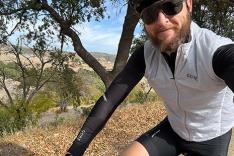Recovery Hydration
Racers on Team Sky are weighed after each stage and they each drink 1.5 times the body weight lost. You should drink to satisfy your thirst and keep drinking until you've replaced all the body weight you've lost, i.e., drink 16 fluid ounces for every pound lost.
Water is a good start. Here are some other choices: Fruit juices provide calories and potassium. Vegetable juices such as V-8 provide carbohydrate and plenty of sodium. Low-fat or non-fat regular or chocolate milk both provide lots of calories. You can also make a smoothie mixing non-fat milk or yogurt, fruit and some sugar or honey in a blender.
Sports drinks and recovery drinks are no better than real food and cost more. Although a beer may taste good, you're substituting empty calories from alcohol for quality calories from carbohydrate.
More: Cycling Hydration Myths
Recovery Electrolytes
How much sodium you lose in sweat and the sodium concentration of your sweat depends on your genetics, diet, fitness, heat acclimatization, gender, how hard you are riding and the heat and humidity. On a three-hour ride you could lose roughly 1,200-4,800 milligrams (mg) of sodium, which equals 2 to 6 percent of your sodium stores, and also lose 300-1,200 mg of potassium, which is only 0.001 to 0.007 percent of your potassium stores.
Processed foods you buy at the store and restaurant meals are generally high in sodium. Unless you eat a moderate sodium diet following the recommendation of not more than 2,300 mg per day, you probably don't need to worry about sodium losses. If you normally control your sodium intake, eat salty carbohydrate-rich snacks after a hot ride.
More: 2 Ways to Conquer Cramps on the Bike
Sleep
Wiggins attributed his Tour de France victory to paying attention to all the little factors that affect recovery, including getting to bed early. Many of us try to combine athletic performance with busy personal and professional lives and as a result are short on sleep. When you are training hard try to get to bed a little earlier and then don't watch TV, surf the net or read so that you relax immediately and drift off to sleep.
More: 3 Reasons You Should Sleep More
Active Recovery
The lymph system is the body's sewage system, moving waste products from the muscles to the lymph nodes. Lymphatic fluid doesn't have a pump like the heart to circulate it; rather it depends on the action of the muscles to move the fluid from the muscles to the lymph nodes. The day after a hard ride, do something active. Go for an easy spin, walk the dog, play catch with the kids or go for a swim in the local pool.
More: Which Recovery Strategy Works Best for Cyclists?
Massage
If we were paid to race we'd get frequent professional massages to help remove waste products and also to reduce Delayed Onset Muscle Soreness, sore stiff muscles the day after a hard ride. I got a weekly massage when I was training for the Race Across America. I also learned how to massage myself, which is described in this self-massage article on my website.
If professional massage isn't an option, work on your legs regularly. If you massage your legs after a hard ride be gentle. If you do it the day after a hard ride, go deeper.
The pros and their coaches have it figured out: train and race hard and recover fully. When you are riding hard you are breaking down your muscles, not getting stronger. You only get fitter when you allow time for your body to recover. By using these tips you'll improve the quality of your recovery so that you can ride even better.
More: Rub Out Sore Legs With Massage
 Ready to ride? Search for a cycling event.
Ready to ride? Search for a cycling event.- 2
- of
- 2
About the Author









Discuss This Article